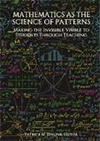
Mathematics as the Science of Patterns
Making the Invisible Visible to Students Through Teaching
Edited by:
Patrick M. Jenlink, Stephen F. Austin State University
Published 2022
Mathematics as the Science of Patterns: Making the Invisible Visible to Students through Teaching introduces the reader to a collection of thoughtful, research-based works by authors that represent current thinking about mathematics, mathematics education, and the preparation of mathematics teachers. Each chapter focuses on mathematics teaching and the preparation of teachers who will enter classrooms to instruct the next generation of students in mathematics.
The value of patterns to the teaching and learning of mathematics is well understood, both in terms of research and application. When we involve or appeal to pattern in teaching mathematics, it is usually because we are trying to help students to extract greater meaning, or enjoyment, or both, from the experience of learning environments within which they are occupied, and perhaps also to facilitate remembering. As a general skill it is thought that the ability to discern a pattern is a precursor to the ability to generalize and abstract, a skill essential in the early years of learning and beyond.
Research indicates that the larger problem in teaching mathematics does not lie primarily with students; rather it is with the teachers themselves. In order to make changes for students there first needs to be a process of change for teachers. Understanding the place of patterns in learning mathematics is a predicate to understanding how to teach mathematics and how to use pedagogical reasoning necessary in teaching mathematics. Importantly, the lack of distinction created by the pedagogical use of patterns is not immediately problematic to the student or the teacher. The deep-seated cognitive patterns that both teachers and students bring to the classroom require change.
Chapter 1 opens the book with a focus on mathematics as the science of patterns and the importance of patterns in mathematical problem solving, providing the reader with an introduction. The authors of Chapter 2 revisit the work of Po lya and the development and implementation of problem solving in mathematics. In Chapter 3, the authors present an argument for core pedagogical content knowledge in mathematics teacher preparation. The authors of Chapter 4 focus on preservice teachers’ patterns of conception as related to understanding number and operation. In Chapter 5 the authors examine the role of visual representation in exploring proportional reasoning, denoting the importance of helping learners make their thinking visible. The authors of Chapter 6 examine patterns and relationships, and the importance of each in assisting students’ learning and development in mathematical understanding. The authors of Chapter 7 examine the use of worked examples as a scalable practice, with emphasis on the importance of worked examples in teaching fraction magnitude and computation is discussed. In Chapter 8, the authors expand on the zone of proximal development to investigate the potential of Zankov’s Lesson in terms of students analyzing numerical equalities. The authors of Chapter 9 focus on high leverage mathematical practices in elementary pre-service teacher preparation, drawing into specific relief the APEX cycle to develop deep thinking. In Chapter 10, the author focuses on number talks and the engagement of students in mathematical reasoning, which provides opportunities for students to be sensemakers of mathematics. Chapter 11 presents an epilogue, focusing on the importance of recognizing the special nature of mathematics knowledge for teaching.
CONTENTS
Preface. Acknowledgments. Mathematics—The Science of Patterns: The Importance of Patterns in Teaching and Learning Mathematics, Patrick M. Jenlink. Po lya Revisited: The Development and Implementation of a Problem-Solving Self-Efficacy Instrument With Preservice Elementary Mathematics Teachers, James Telese and Jair J. Aguilar. What Should We Teach in Elementary Mathematics Methods Courses? The Argument for Core Pedagogical Content Knowledge in K–5 Mathematics Teacher Preparation, Courtney Glavich Mayakis and John Williams. Effectiveness of Diagnostic Interviews: Preservice Teachers’ Patterns of Conceptions in Student Understanding of Number and Operation, Diana L. Moss, Lisa L. Poling, and Tracy Goodson-Epsy. Using Visual Representations to Explore Proportional Reasoning With Future Teachers, Sheri Johnson and Rui Kang. Patterns and Relationships Within Ratio Contexts: Students’ Emerging Ideas Through Tables, Sinem Sözen Özdoğan, Didem Akyüz, and Michelle Stephan. Using Worked Examples as a Scalable Practice for Teaching Fraction Magnitude and Fraction Computation, Kathryn J. deVries, Julie L. Booth, Laura K. Young, Christina Areizaga Barbieri, Emunah Mager Garfield, and Kristie J. Newton. Expanding a Collective Zone of Proximal Development: Investigating the Potential of Zankov’s Lesson With Elementary Students Analyzing Numerical Equalities, Åsmund Gjere and Viktor Freiman. Engaging Elementary Preservice Teachers With High Leverage Mathematical Practices, Christopher Nazelli, Deborah Zopf, and S. Asil Özgün-Koca. Number Talks: Engaging Students in Mathematical Reasoning, Dawn Marie Woods. Epilogue: Recognizing the Special Nature of Mathematics Knowledge for Teaching, Patrick M. Jenlink. About the Editor and Authors.
-
Paperback978-1-64802-744-4
Web price: $45.04 (Reg. 52.99)
-
Hardcover978-1-64802-745-1
Web price: $80.74 (Reg. 94.99)
- eBook978-1-64802-746-8

- EDU029010 - EDUCATION: TEACHING METHODS & MATERIALS: Mathematics
- MAT030000 - MATHEMATICS: Study & Teaching
- EDU003000 - EDUCATION: Aims & Objectives
-
 A Practical Guide to Exemplary Professional Development Schools
A Practical Guide to Exemplary Professional Development Schools
-
 Catalytic Improvement Communities
Cultivating Flourishing Schools
Catalytic Improvement Communities
Cultivating Flourishing Schools
-
 Conceptualizing Truth
Implications for Teaching and Learning
Conceptualizing Truth
Implications for Teaching and Learning
-
 Diversity as Strategic Opportunity
Exploring New Paths to Good Administration
Diversity as Strategic Opportunity
Exploring New Paths to Good Administration
-
 Multilevel Modeling Methods with Introductory and Advanced Applications
Multilevel Modeling Methods with Introductory and Advanced Applications
-
 The AMTE Handbook of Mathematics Teacher Education
Reflection on Past, Present and Future – Paving the Way for the Future of Mathematics Teacher Education, Volume 5
The AMTE Handbook of Mathematics Teacher Education
Reflection on Past, Present and Future – Paving the Way for the Future of Mathematics Teacher Education, Volume 5
-
 The Undivided Life
Faculty of Color Bringing Our Whole Selves to the Academy
The Undivided Life
Faculty of Color Bringing Our Whole Selves to the Academy

